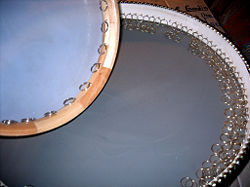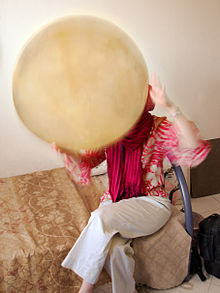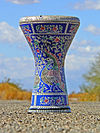- Daf
-
For other meanings of DAF, daf, daff or similar, see DAF.
Daf 
Other names Dafli, Dap, Def, Tef, Defi, Gaval, Duf Classification hand percussion Playing range High sound of jingles, plus some have a skin with a lower sound. Related instruments Riq, Buben, Dayereh, Tambourine, Kanjira, Frame drum A daf (Arabic, Persian, Urdu::دف) is a frame drum used as a musical instrument in popular and classical music. The term daf is used in Iran (Persia) / Kurdistan for a large drum that has a series of four interlinked rings in the frame.[1] Daf is mostly used in Middle East, Iran, Armenia, Pakistan, Turkey, Tajikistan, Azerbaijan and India. Some dafs are equipped with rings or small cymbals, making them a form of tambourine.
The defi (sometimes called daire in other areas) is a fairly large frame drum with metal bangles. It is similar to a tambourine in construction, the defi is made with a metal screw system so that the head can be tightened and tuned. It is popular in many forms all over Greece, especially in the mainland klarino music. The defi is particularly popular in the Epirus region of northwestern Greece, where they are still handmade today. They have a beautiful low tone, and the bangles are low pitched as well. A virtuoso defi player can decorate the rhythm of the songs in many exciting ways.
A daf is depicted on the reverse of the Azerbaijani 1 qəpik coin minted since 2006[2] and on the obverse of the Azerbaijani 1 manat banknote issued since 2006.[3]
Contents
History
 Daf in a miniature, Isfahan, Iran.
Daf in a miniature, Isfahan, Iran.
The earliest evidence of the daf dates back to Sassanid Iran. The Pahlavi (an ancient Iranic language) name of the daf is dap. The word daf is therefore the Arabicized form of the word dap. Some pictures of dap have been found in paintings that date before the Common Era. The presence of Iranian dap in the reliefs of Behistun is enlightening and is hard proof that dafs existed long before the rise of Islam. Dafs were part of religious music in Iran much before Sufism. In fact, Iranian music has always been a spiritual tool. It shows that dafs played an important role in Mazdean Iran emerging as an important element during the Sassanian times during the Kâvusakân dynasty. The monuments of Behistun are situated 25 km (16 mi) from Kermanshah city. Also there is a kind of square frame drum in the stonecutting of Taq-e Bostan (another famous monument located 5 km (3 mi) northeast of Kermanshah city). These frame drums were played in the ancient Middle East (chiefly by women in Kurd societies), Greece, and Rome and reached medieval Europe through Islamic culture.[citation needed]
Norouz (the first day of the Iranic New Year and the national festival of the Iranic peoples) and other festive occasions have been accompanied by dap in Sassanid periods (224 A.D. - 651 A.D.). In this period the dap was played in order to accompany Iranian classical music. Undoubtedly daps were used in the court to be played in the modes and melodies of traditional music. This traditional or classical music was created by Barbod the Great and was named the khosravani after the King Khosrow (Chosroes). Recent research reveals that these modes were used in the recitation of Mazdean (Zoroastrian) prayers. The modes were passed down from master to student and are today known as the Radif and Dastgah system. Many of the melodies were lost, but most of those that remain date to the Sassanid period. Dafs can be played to produce highly complex and intense rhythms, causing one to go under a trance and reach an ecstatic and spiritually-high state. For this reason, they have always been connected with religion in Iran, again, much before Islam.
The Moors introduced the daf and other Middle Eastern musical instruments to Spain, and the Spanish adapted and promoted the daf and other musical instruments (such as the guitar) in medieval Europe. In the 15th century, the daf was only used in Sufi ceremonies; the Ottomans reintroduced it to Europe in the 17th century.
The art of daf playing in Iranian Kurdistan and other parts of Iran has reached us by the effort of Iranian Sufis; especially in the 20th century by the late Sayyed Baha-al-Din Shams Ghorayshi (1872–1947), Ostad Haj Khalifeh Karim Safvati (1919-…), Ostad Haj Khalifeh Mirza Agha Ghosi (1928-…), Mohi-al-Din Bolbolani (1929-…), Sayyed Mohammad Shams Ghorayshi (1930-…) and Masha-Allah Bakhtiyari (1940-…).
The daf still functions as an important part of Kurdish and Persian art music (traditional or classical music) as it did in ancient times. It successfully encourages many young Iranians to take up learning this ancient instrument.
A thin band made of hardwood, covered with goatskin on one side. It can also have rings or small cymbals along the rim. In these regions, the daff is held with both hands at shoulder height. Tones of various depth and colours are played by hitting different spots on the skin with the fingers. There is also an Oriental technique of leaning the daff against the knees. The daff is a percussion instrument with a soft, deep tone. It is suitable for playing indoors and to accompany singers and players on the tambura, violin, oud, saz and other Oriental instruments.
Dayereh
The dayereh is an instrument that is used to keep the rhythm of the music.
The membrane is made of goatskin stretched over a wooden ring. Along the edge of the dayereh there are several pairs of loosely attached metal disks, which produce short crisp sounds as the player strikes the dayereh with the wrist and the fingers.
Traditionally, the dayereh is a female instrument. It is sometimes used on festive occasions.
Cultural reference
It is the National Instruments of Pakistan unofficial.[citation needed]
See also
References
- ^ World music and persussions by Scott Robinson Retrieved 2004
- ^ Central Bank of Azerbaijan. National currency: New generation coins. – Retrieved on 25 February 2010.
- ^ National Bank of Azerbaijan. National currency: 1 manat. – Retrieved on 25 March 2009. (Old site -now a dead link- that mentioned the instrument as a daf).
Central Bank of Azerbaijan. National currency: 1 manat. – Retrieved on 25 February 2010. (Current site that mentions the instrument as a drum).
- Daf (tambour mystique) par Madjid Khaladj - Anthologie des rythmes iraniens / Buda Musique - CD volume 2
- Nafas/ Infinite Breath : Madjid Khaladj (Daf, Dayereh, Tombak, Zang, Zurkhaneh..) / CD Ba Music Records
External links
- Nay-Nava the Encyclopedia of Persian Music Instruments
- Different Dafs
- Daf, the Spiritual Frame Drum
- Frame Drummer Forum
- Daf, Workshops, Events, Sale
- http://www.greekfolkmusicanddance.com/instruments.php
Percussion instruments Tuned agogô · balafon · bell · bells · bonang · caisa · carillon · celesta · crotales · flexatone · glockenspiel · gong · handbell · handchime · hang · jal tarang · kulintang · kulintang a kayo · marimba · octoban · skrabalai · steelpan · spinet · tank drum · timpani · tubular bells · vibraphone · xylophoneNon-tuned agogô · bass drum · batá drum · bell tree · bock-a-da-bock · bodhrán · bongo drum · cabasa · cajón · castanets · chácaras · china cymbal · clapsticks · claves · cowbell · conga drum · crash cymbal · cymbal · djembe · darabouka · dayereh · floor tom · gong · güiro · headless tambourine · hi-hat · jam block · lagerphone · maracas · Manjira · mark tree · pandeiro · ratchet · ride cymbal · rototom · rute · sizzle cymbal · snare drum · splash cymbal · spoons · swish cymbal · tabor · taal · tambourine · temple blocks · thunder sheet · timbales · tom-tom · triangle · vibraslap · washboard · whip · wind chime · wood blockRelated Percussion PortalIranian musical instruments Stringed
(Sāzhāy-e Zehī)BowedPluckedStruckWoodwind
(Sāzhāy-e Bādī)ExposedEnd-blownPercussion
(Sāzhāy-e
Kūbeheyī/Zarbī)AuxiliaryDarāy · Daf · Dohol · Dāvūl · Dāyereh Zangī · Naqāreh · Tonbak (Dombak) · Kūs · Sanj · Dammam · Zarbang UduTurkish musical instruments String instruments: █ Bowed instruments: Kemençe • Yaylı tanbur • Rebab • Kabak kemane • Sine kemanı
█ Plucked instruments: Kanun • Çeng • Tanbur (Turkish) • Ud • Cümbüş • Ahenk • Saz • Baglama • Komuz • Shahrud • Rud • Lavta • Mugni█ Struck instruments: SanturWoodwind instruments █ Exposed: Zurna • Tulum • Karkm • Dankiyo • Gaida • Düdük • Çifte █ End-blown: Ney • Ney (Turkish) • Kaval • Sipsi • Dilli Kaval • Dilli ney • Mey • Taragot • Dilli düdük • Kargı DüdükPercussion instruments See also Traditional Arabic musical instruments Plucked lutes Zithers Bowed lutes Lyres Flutes Reed instruments Drums Other percussion Categories:- Percussion instruments
- Arabic musical instruments
- Iranian musical instruments
- Azerbaijani musical instruments
- Kazakhstani musical instruments
- Uzbekistani musical instruments
- Kyrgyz musical instruments
- Dagestanian musical instruments
- Turkmen musical instruments
- Afghan musical instruments
- Pakistani musical instruments
- Uyghur musical instruments
- Hand drums
- Turkish musical instruments
Wikimedia Foundation. 2010.





